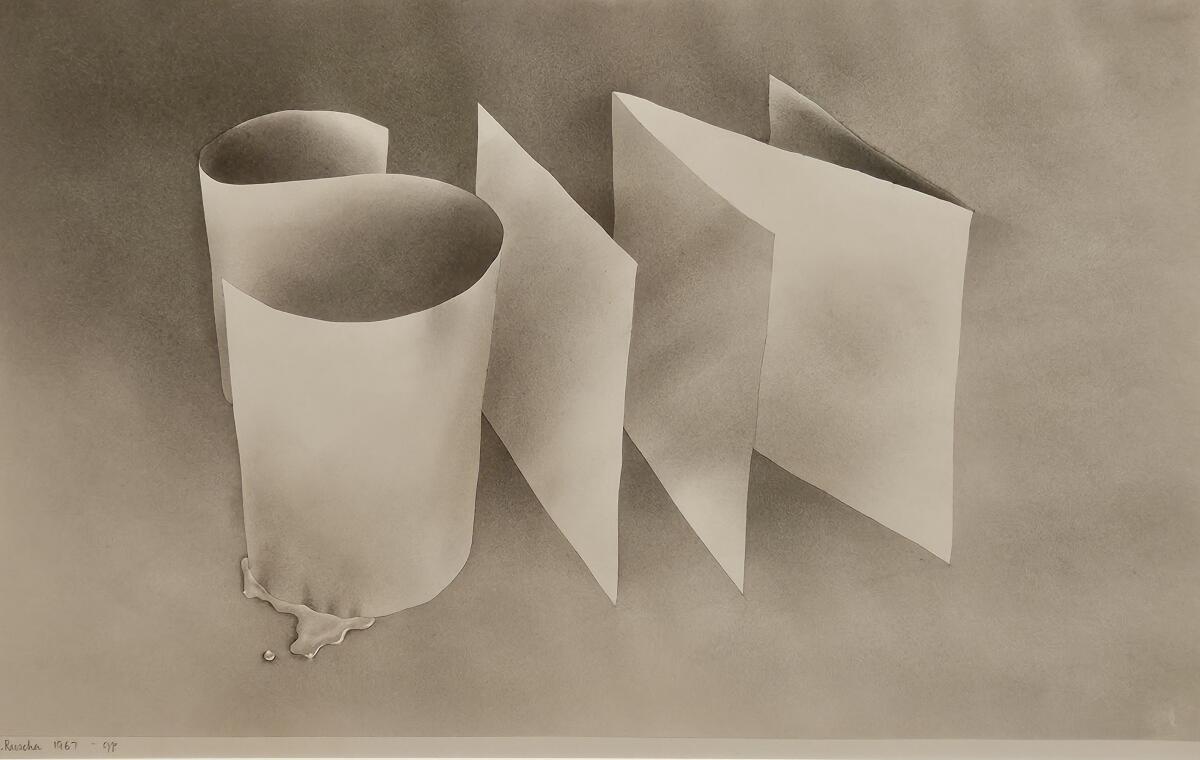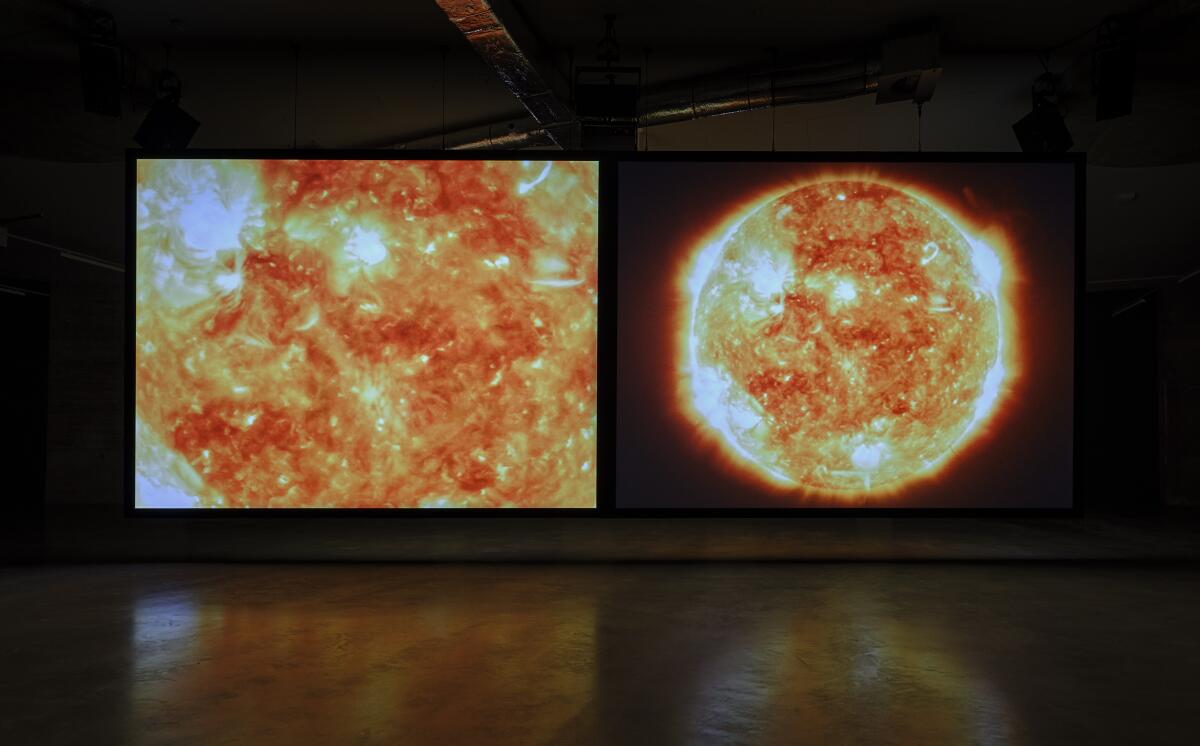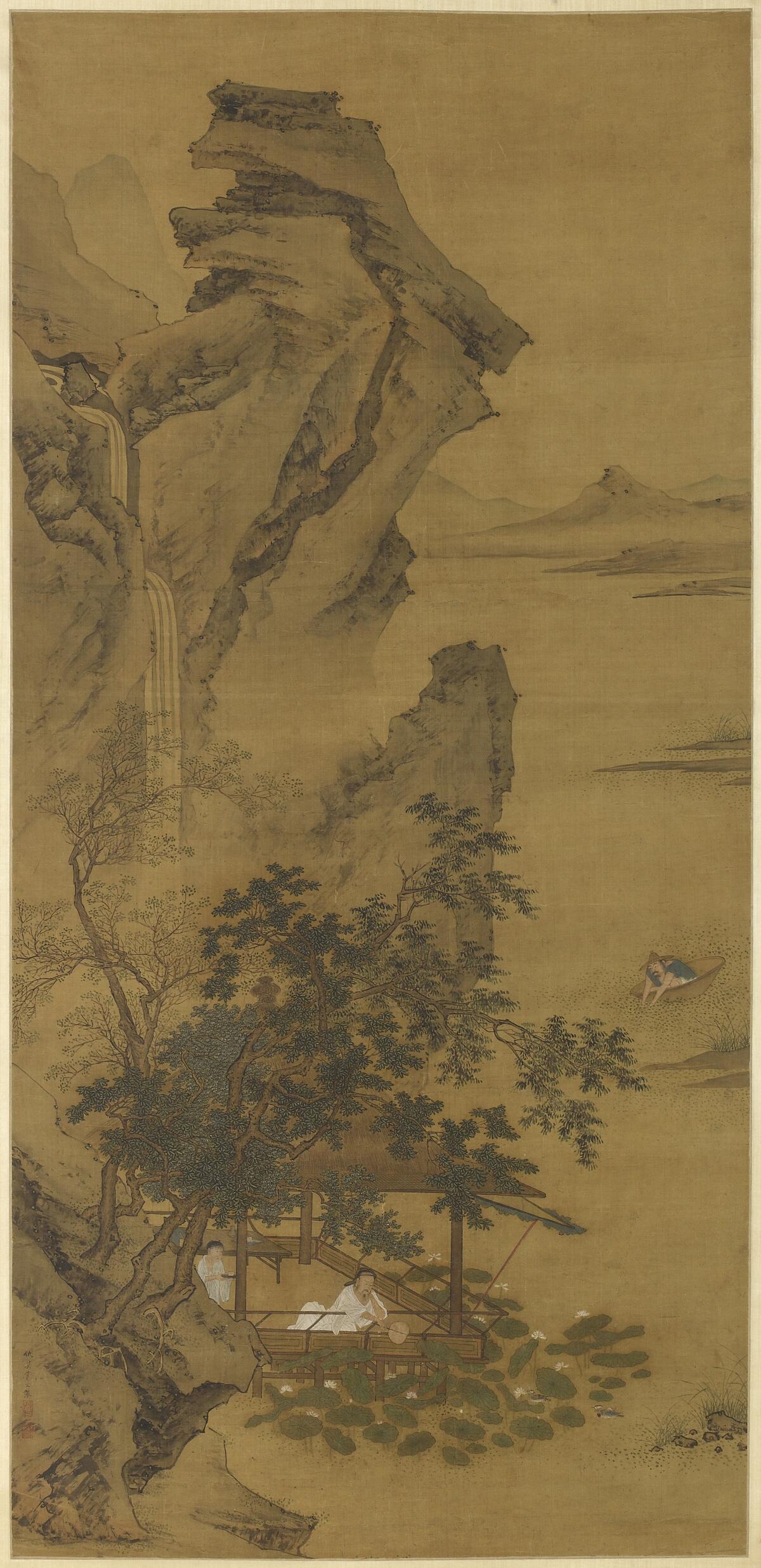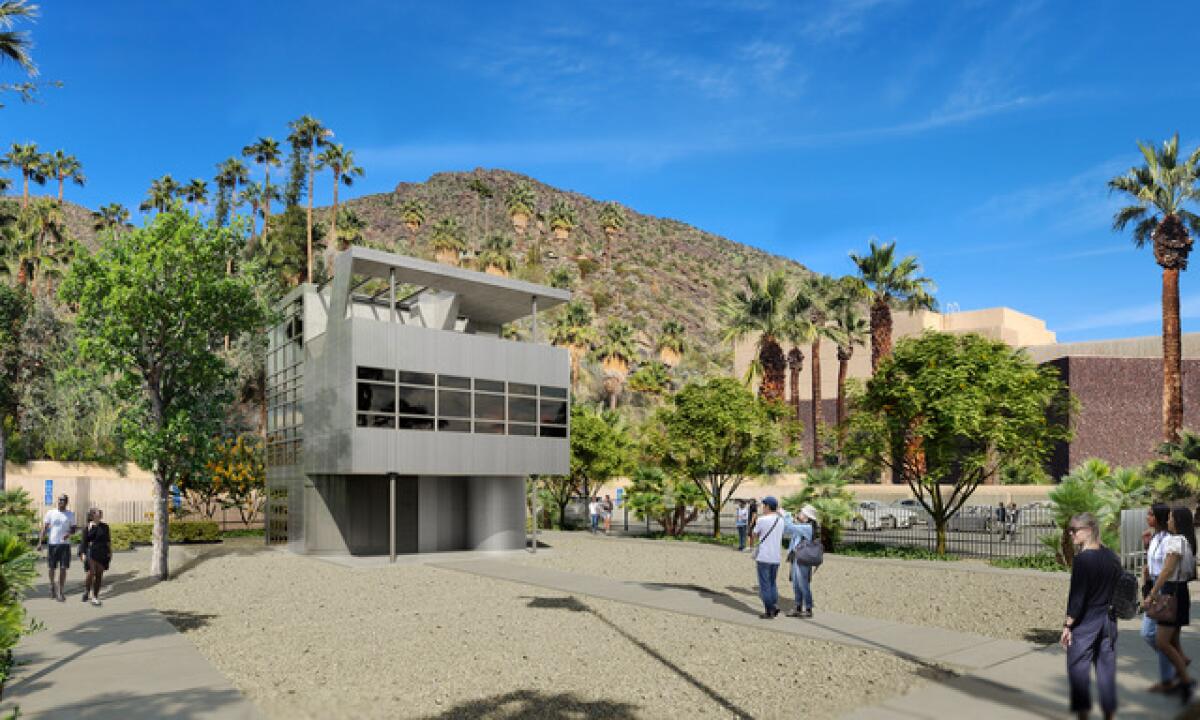Baby, you can drive my car: Ed Ruscha’s parking lots

Today is National Restless Leg Awareness Day, designated to promote familiarity with a relatively rare medical condition identified in 1945 by Swedish neurologist Karl-Axel Ekbom. (Sept. 23 is his birthday.) I’m Times art critic Christopher Knight, filling in on the Essential Arts Newsletter for columnist Carolina A. Miranda.
Make the most of L.A.
Get our guide to events and happenings in the SoCal arts scene. In your inbox once a week.
You may occasionally receive promotional content from the Los Angeles Times.
At MoMA, “Ed Ruscha: Now Then” inspires reminiscence
When I graduated from college in New York, a professor who had opened my eyes to the magic and mysteries of contemporary art gave me a modest graduation present — a small, slim, 1967 chapbook, “Thirtyfour Parking Lots in Los Angeles” by artist Ed Ruscha. Never having been to California, I knew next to nothing about him or his work. But the unadorned and unpopulated black-and-white photographs were oddly captivating — aerial views of the asphalt in empty parking venues at places bland and beautiful, like a plain office building on Wilshire Boulevard and glamorous Dodger Stadium, all apparently shot from a hovering helicopter. (Page through the book here.)
What was this weird picture book? And who was this Ruscha guy?
“Here’s hoping you find your space in the parking lot of life,” read my professor’s dry and knowingly sentimental inscription, and in 1976 I did. I moved to Southern California.
Since then, I’ve seen a lot of parking lots. I’ve also seen a lot of Ruscha’s prolific art, and I’m a fan. This week I wrote about the big, wonderful, 60-year retrospective of some 200 paintings, drawings, prints, books and an installation at New York’s Museum of Modern Art by the artist, who is now 85. (You can find my review here.) I’ve seen countless smaller Ruscha exhibitions over the years, but this is the third wide-ranging overview to offer a deep dive.

In 1982 the San Francisco Museum of Modern Art assembled a midcareer survey, which traveled the following year to the Los Angeles County Museum of Art. In 1990 it was the Museum of Contemporary Art’s turn, as a show of paintings jointly organized in Europe by the Centre Pompidou in Paris and the Museum Boijmans-von Beuningen in Rotterdam went to Barcelona, London and, finally, L.A. The MoMA show is headed to LACMA next April. You know an artist is great when, no matter how much work you see, you keep seeing something new — even in things you thought you already knew.
I still have my copy of “Thirtyfour Parking Lots in Los Angeles,” and when I got back to town from New York, it had acquired another unexpected layer. Thanks to Hollywood, L.A. is a city constructed from cameras. Also, as the first suburban rather than urban megalopolis to really gain international traction, camera images of its car culture infrastructure are telling. The parking lot photographs, which could be described as “unforthcoming,” since they are uninflected, unemotional and unexciting, have always operated within a peculiar space between document and art.
The parking lots put you in mind of the methodically recorded blast furnaces, cooling towers and other fading industrial artifacts of German artists Bernd and Hilla Becher, and what became the New Topographics movement of American landscapes of tract homes and industrial parks by Lewis Baltz, Robert Adams and several others. And the layouts of parking places look like giant, abstract Minimalist drawings. Still, I couldn’t help thinking of another angle.
A literal one. As aerial views that record a vacant suburban form and pattern, the photographs look down on Los Angeles. In 1967, so did the American cultural establishment.
Ruscha’s art is filled with witty and insightful wordplay and puns, and this one now clings to the little volume. Today, given the city’s stature as a universally recognized center for the production of new art — a standing that Ruscha was instrumental in creating with penetrating works like this — the photo book has morphed into a historical marker. “Thirtyfour Parking Lots in Los Angeles” is having the last laugh.
Onstage
“Every Brilliant Thing,” an interactive 2013 solo performance piece by British theater artists Duncan Macmillan and Jonny Donahoe, has been seen in L.A. once before. But Times theater critic Charles McNulty says the current presentation at the Geffen Playhouse, featuring an affable Daniel K. Isaac, is “at once more abstract and more emotionally forthcoming.” The audience gets in on the act, as members are conscripted to play brief roles onstage as different as the narrator’s father and a veterinarian tasked with putting down a beloved pet.
Buy, don’t burn, a banned book

Nazism came to Missouri this week, as a viral video showed two Republican state senators wielding flamethrowers to demonstrate how they plan to burn books they think are inappropriate for schools. The violent display features state senators Nick Schroer and Bill Eigel, a conservative Christian former Air Force captain who is running for governor next year. Schroer told the Kansas City Star the video was taken during an event called Freedom Fest, hosted by the St. Charles County Republican Central Committee, to help them raffle off a flamethrower. (Those are apparently handy to have around the house.) The pair were torching cardboard boxes in a trial run. Debbie McFarland, a committee member and organizer of the event, defended the threatening action, calling criticism of the video a “liberal leftist narrative.” She’s probably right.
The blue-chip brigade
Marian Goodman has been in the art business since 1965, first as a publisher of art multiples, then as a gallery owner (since 1977), eventually with spaces in New York, London and Paris. The London venue closed a few years back, a casualty of Brexit’s economic shifts. But Goodman, 95, today opens a Hollywood outpost with an exhibition of a 2022 installation work by British artist Steve McQueen.

Just off Santa Monica Boulevard, two blocks east of Regen Projects, Marian Goodman Gallery joins an influx to Los Angeles of blue-chip New York galleries. Among them are Matthew Marks, David Zwirner, Sean Kelly, Hauser & Wirth, Pace and Lisson. (Gagosian — the biggest of them all — doesn’t count, since that Beverly Hills gallery first launched in Westwood and West Hollywood four decades ago, then moved east — and around the world.) The McQueen opener checks two related boxes: A terrific artist whose Minimalist video works have been widely acclaimed (he won the 1999 Turner Prize), he’s also an accomplished director of popular movies and television (his remarkable 2013 film “12 Years a Slave” won the Academy Award for Best Picture).
Admiring lotuses at the Huntington
One big loss during the 2020 pandemic was the LACMA exhibition “Where the Truth Lies: The Art of Qiu Ying.” The first survey outside Asia of the great Ming dynasty painter was shuttered not long after it opened, cutting short a planned run of seven months.

A bit of what we missed will be going on view Dec. 9 in the galleries of the Huntington Art Museum, which announced last week that it had acquired Qiu’s hanging scroll, “Zhou Dunyi Admiring Lotuses,” dating from the 1530s. Qiu Ying (c. 1494–c. 1552) worked in Suzhou, just west of Shanghai, a city whose gardens the museum says inspired its own impressive Chinese Garden. A waterfall cascades down from a mountain, disappearing behind a grove of trees, leading the eye to a thatched pavilion where philosopher Zhou Dunyi (1017–1073) leans over a railing to contemplate lovely lotus flowers floating on a pond. The world might be difficult, Zhou had written, but small pleasures allow us to rise above it. Qiu’s paintings do too.
If you build it, will they come?
In Burbank, Woodbury University students designed and constructed a 425-square-foot home using the latest 3-D printing technology — the first of its kind permitted in Los Angeles. Times columnist Carolina A. Miranda writes that the Solar Futures House, as it is formally known, is “an impressive piece of design, achieving a lot in a small space.” Ideas embodied in the climate-change-savvy concrete structure might help forge a path to alleviating our crushing housing crisis.

Meanwhile, a historic example of new technology applied to possible mass production for housing is going up in the Coachella Valley, where site work has just begun in a former parking lot adjacent to the Palm Springs Art Museum. Albert Frey‘s avant-garde 1931 Aluminaire House™, a space-age aluminum structure acquired a while back by the museum and painstakingly restored, will be permanently installed there.
Completion is aimed for early next year, during the exhibition run of “Albert Frey: Inventive Modernist,” guest curated for PSAM by designer Brad Dunning. (The show runs Jan. 13 to June 3 at the museum’s Architecture and Design Center.) Architect and PSAM trustee Leo Marmol is slated to speak at the museum Oct. 21 on the influence of Swiss-born Frey, who lived in the desert from 1939 until his death in 1998.

Moves
Craft Contemporary has a new executive director: Rody N. López succeeds retiring director Suzanne Isken. With a background in both art and healthcare marketing and fundraising, López starts immediately.
Belinda Tate, executive director at the Kalamazoo Institute of Arts in Michigan, has been named director of the Indianapolis Museum of Art, effective Nov. 6.
Passages
Tony Award-winning actor Michael McGrath, who played Patsy, King Arthur’s sidekick, in the musical “Spamalot,” among numerous other roles on and off Broadway, has died at 65.
Street photographer Marvin Newman, who contributed to Sports Illustrated, Life, Esquire and other magazines, has died at 95.
Peter Mullin, a founding board member of the Petersen Automotive Museum, has died at 82.
In the news
— The estate of John Baldessari, the Los Angeles artist instrumental in the development of Conceptual art who died in 2020, is currently embroiled in a pair of nasty lawsuits.
— Sculptor Ann Hamilton‘s “Kahnop,” paving that features 1,300 quotes from an estimated 300 sources connected to UC San Diego, is the newest outdoor commission completed for the university’s widely admired Stuart Collection.
— Turmoil greeted the recent school-year opening of the Cleveland Institute of Music, as students refused to play in protest against the return of conductor Carlos Kalmar, CIM’s director of orchestral studies, accused of bullying and sex discrimination.
— Sixteen climate activists were arrested Monday after attempting to protest overnight at New York’s Museum of Modern Art, upset that much of the vast wealth of billionaire museum board chair Marie-Josée Kravis comes from the fossil fuel projects of her husband’s private equity firm, Kohlberg Kravis Roberts. Among the reported protest signs: a picture of Ed Ruscha’s painting of a Standard gas station on fire.
— Istanbul’s newly restored Zeyrek Çinili Hamam, a cavernous and elegant Turkish bath dating back to the 16th century and Ottoman rule, will host an exhibition titled “Healing Ruins,” featuring the work of 22 artists and opening Sept. 30.
— After 45 years, New York’s Second Stage theater co-founder Carole Rothman has stepped down.
— A Japanese bronze Buddha from the Edo period (1603-1867) weighing 250 pounds and valued at $1.5 million was stolen from L.A.’s Barakat Gallery Monday. Security camera footage reportedly shows a single individual with a Budget rental truck pulling off the heist at 2:30 a.m.
— Grace Aneiza Ali of Florida State University is the new editor-in-chief of Art Journal Open, an open-access digital journal for the visual arts affiliated with the College Art Assn.
And last but not least ...
The biggest entertainment stories
Get our big stories about Hollywood, film, television, music, arts, culture and more right in your inbox as soon as they publish.
You may occasionally receive promotional content from the Los Angeles Times.




